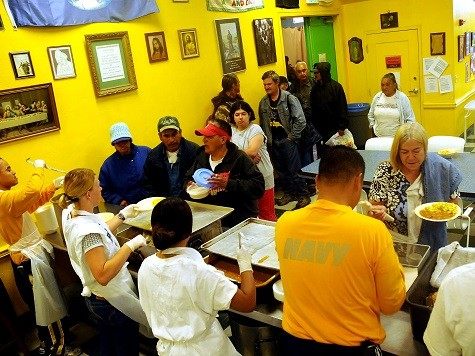A new study which uses disputed figures on food bank usage has blamed the Conservative-led government for the increasing numbers of people reliant on the service. However, the way the left-leaning Trussell Trust calculates food bank custom has led to allegations that it deliberately inflates user numbers to exaggerate the problem.
According to the Trussell Trust over 900,000 people have used food banks in the last year, but this is not 900,000 different people. Users who come several times in one year are added to the total each time they receive a three-day parcel of food. The Trust explains this by saying that under normal circumstances an individual cannot use the service more than three times a year, but it does concede they would be counted as three different people if they did.
The extraordinary rises in food bank usage are also the subject of dispute. Every time a food bank affiliates to the Trussell Trust it is classified as a “new food bank”. It will be added to the statistics on how many new food banks have opened in the UK, which has been significant. In 2010 there were only 29 affiliates, but there are now 251, it is not clear how many of these opened recently but for the purposes of the statistics that is how they are all classified.
Every one of the existing food banks users are classified as if they had only just presented themselves, even if they had been using the service for decades. This gives the impression there has been an explosion in food bank usage recently, whereas all the statistics really prove is the Trussell Trust is increasing its membership. It is effectively a trade association, and actively seeks new members.
Despite the problems, researchers at Oxford University used the statistics to claim there was “clear evidence” linking increased food bank with government cuts. The report said: “More food banks are opening in areas experiencing greater cuts in spending on local services and central welfare benefits and higher unemployment rates.
“The rise in food bank use is also concentrated in communities where more people are experiencing benefit sanctions. Food parcel distribution is higher in areas where food banks are more common and better established, but our data also show that the local authorities with greater rates of sanctions and austerity are experiencing greater rates of people seeking emergency food assistance.”
Last year a senior Department for Work and Pensions source accused the Trussell Trust of “misleading and emotionally manipulative publicity-seeking”. Another official said the rise in food bank use was down to the Trust “aggressively marketing their services”.
The Trussell Trust also claimed last year to have dished out 20 million meals to people too poor to buy food. However, it was later revealed at least half of the meals were given to charitable groups like lunch clubs. Most of these clubs exist for social purposes, not because their users are unable to afford to eat.

COMMENTS
Please let us know if you're having issues with commenting.